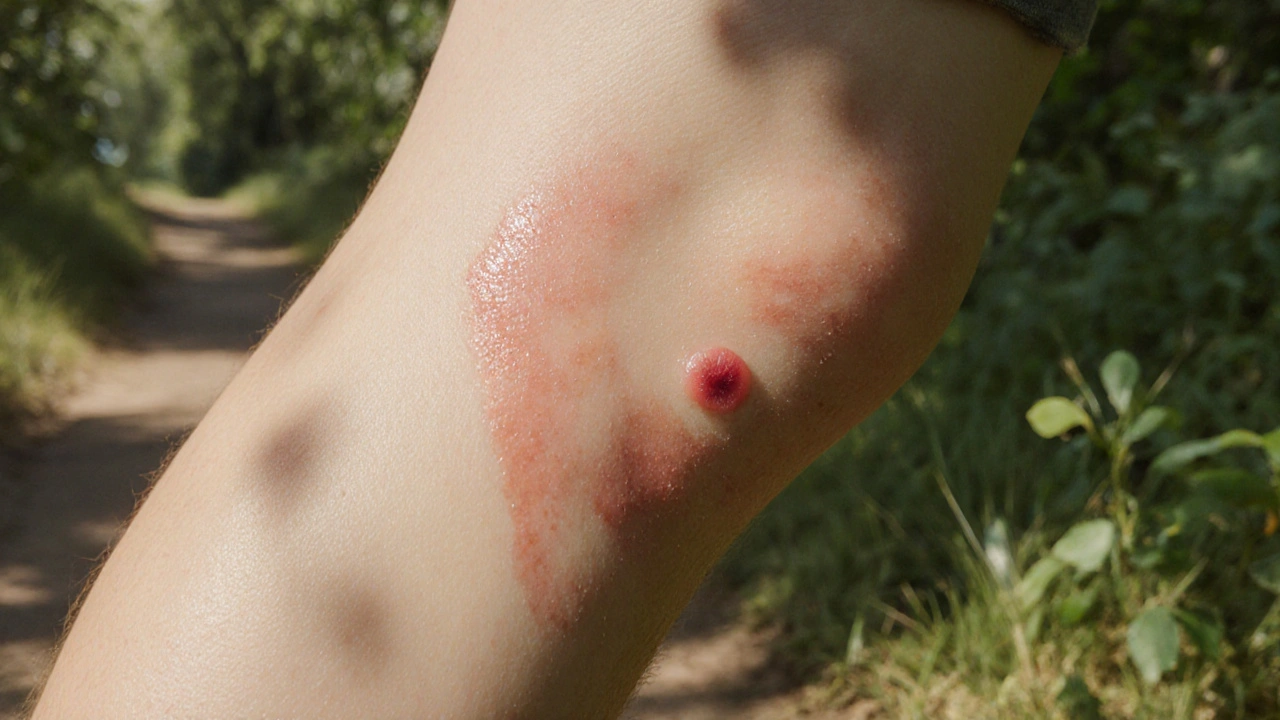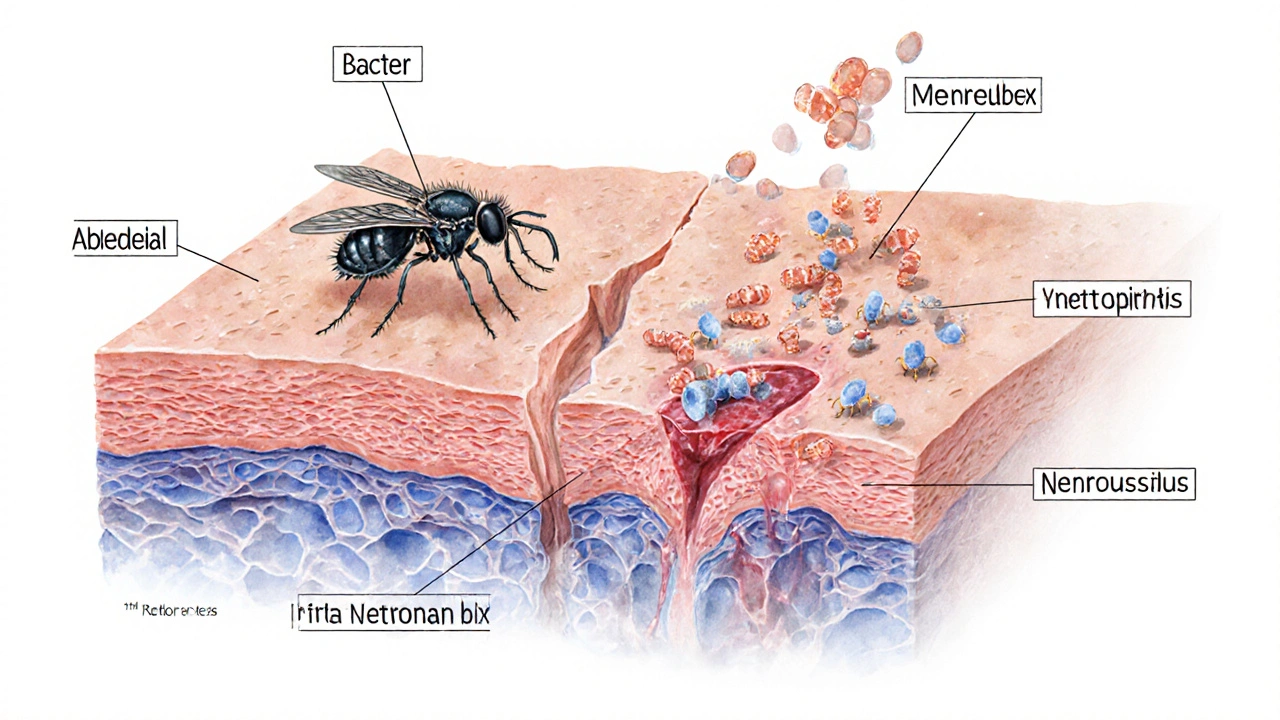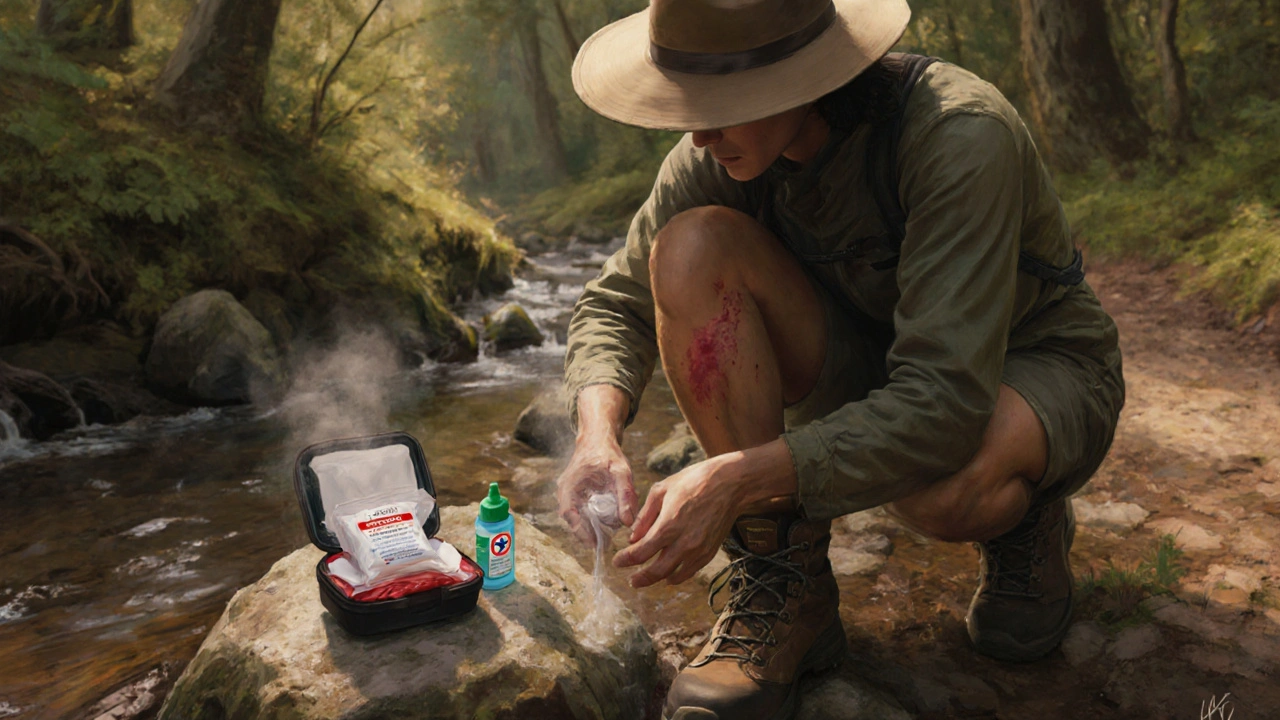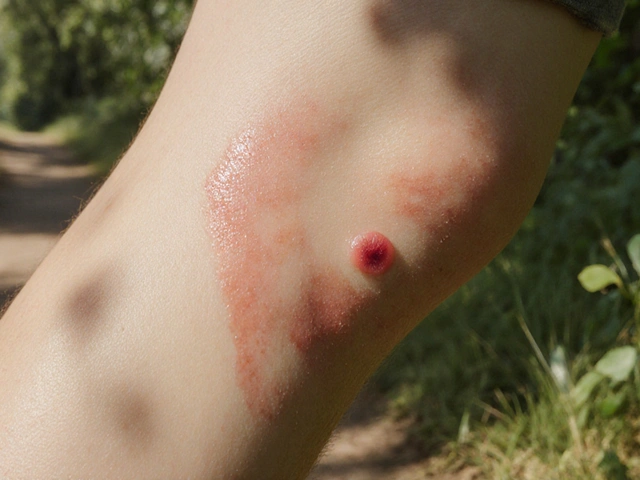
Abrasions and Insect Bites Symptom Checker
| Symptom | Abrasion Only | Insect Bite Only | Combined Injury |
|---|---|---|---|
| Redness | Localized, uniform | Ring-shaped, may spread | Intense, irregular pattern |
| Swelling | Minor, limited to edges | Often noticeable around puncture | Enhanced, may feel tight |
| Itching | Occasional, mild | Strong, constant urge to scratch | Severe, leading to secondary infection |
| Pain | Sharp at time of injury, then dull | Usually mild, may increase if inflamed | Sharp + burning sensation |
| Discharge | Serous fluid, clear | Rare, unless infected | Pus or yellowish fluid - sign of infection |
Enter your symptoms and click "Analyze Symptoms" to get a risk assessment.
Key Takeaways
- Abrasions break the skin’s protective barrier, making it easier for insect saliva to cause infection.
- Both abrasions and insect bites can trigger similar symptoms like redness, swelling, and itching.
- Cleaning, antiseptic care, and avoiding scratching are crucial for preventing complications.
- Know when to treat at home and when professional medical help is needed.
- Simple preventive steps-proper clothing, insect repellent, and prompt wound care-reduce the risk of combined problems.
Ever noticed a mosquito bite turning red and sore right after you scrape your knee? That’s not a coincidence. When the skin is compromised by an abrasion, the tiny puncture left by an insect can introduce bacteria, allergens, and irritants straight into the wound. Understanding how these two everyday injuries interact helps you act fast, keep infections at bay, and speed up healing.
What Is an Abrasion?
Abrasion is a superficial wound that scrapes off the outer layer of skin, known as the epidermis. It usually results from friction against a rough surface-think of a tumble on a gravel path or a fall onto concrete. The damaged area may appear as a reddened, raw patch and often oozes a thin layer of serum.
Key attributes of an abrasion include:
- Depth: typically limited to the epidermis or upper dermis.
- Bleeding: minimal to moderate.
- Healing time: 5‑10 days if kept clean.
How Insect Bites Occur
Insect bite is a puncture or sting delivered by an arthropod, such as a mosquito, tick, or flea. The insect inserts its mouthparts and often injects saliva that contains anticoagulants, enzymes, and sometimes pathogens.
Typical features:
- Itchy, raised bump.
- Redness and swelling around the puncture site.
- Potential for allergic reaction or disease transmission (e.g., Lyme disease from ticks).

Why Abrasions and Insect Bites Interact
Both injuries share a common factor: the skin’s protective barrier is broken. When that barrier is compromised, the following chain reactions can happen:
- Increased bacterial entry: Bacteria that normally live on the skin surface (like Staphylococcus aureus) can slip deeper through an abrasion, especially if an insect’s mouthparts disturb the wound.
- Allergen exposure: Proteins in insect saliva can trigger an allergic reaction that is more intense when the skin is already inflamed.
- Delayed healing: Inflammation caused by the bite can slow the healing process of the abrasion, leading to prolonged redness and scabbing.
In short, a bite on or near an abrasion creates a perfect storm for infection, itching, and slower recovery.
Symptoms: Abrasion vs. Insect Bite vs. Combined Injury
| Symptom | Abrasion Only | Insect Bite Only | Both Together |
|---|---|---|---|
| Redness | Localized, uniform | Ring‑shaped, may spread | Intense, irregular pattern |
| Swelling | Minor, limited to edges | Often noticeable around puncture | Enhanced, may feel tight |
| Itching | Occasional, mild | Strong, constant urge to scratch | Severe, leading to secondary infection |
| Pain | Sharp at time of injury, then dull | Usually mild, may increase if inflamed | Sharp + burning sensation |
| Discharge | Serous fluid, clear | Rare, unless infected | Pus or yellowish fluid - sign of infection |
Preventing Problems Before They Start
Simple habits can dramatically cut the risk of a nasty combo.
- Clothing protection: Wear long sleeves, pants, and sturdy shoes when you’re outdoors in areas with rough terrain or many insects.
- Use repellents: Apply EPA‑approved insect repellents containing DEET, picaridin, or oil of lemon eucalyptus on exposed skin.
- Immediate wound cleaning: If you scrape a knee, rinse it under running water within minutes. Use a mild antiseptic (e.g., chlorhexidine) to lower bacterial load.
- Avoid scratching: Scratching can break the skin further, creating another entry point for bacteria.
- Check for ticks: After hikes, inspect your body for ticks, especially in hidden areas like behind the knees.

Step‑by‑Step Care for an Abrasion with an Insect Bite
- Wash your hands. Clean hands with soap and water before touching the wound.
- Rinse the area. Gently flush the abrasion and bite site with lukewarm water. Remove visible dirt or debris.
- Disinfect. Apply a thin layer of an antiseptic solution (e.g., povidone‑iodine). Avoid harsh alcohol that can damage tissue.
- Dry and protect. Pat the area dry with a clean gauze pad. Cover with a breathable, non‑adhesive dressing to keep out insects and dirt.
- Manage itching. Use a topical antihistamine (like diphenhydramine cream) or a cool compress to reduce the urge to scratch.
- Monitor for infection. Look for increasing redness, warmth, swelling, or pus. If any appear, seek medical advice promptly.
- Change dressings. Replace the dressing once a day or when it becomes wet. Re‑apply antiseptic each time.
Following these steps gives the skin a clean environment to heal and blocks the pathway for bacteria that might have been delivered by the insect.
When to Seek Professional Help
Most minor abrasions and bites heal on their own with proper care. However, watch for these red flags that signal a deeper issue:
- Fever above 38°C (100.4°F) within 48hours.
- Rapidly spreading redness extending more than 2cm from the wound.
- Severe pain that wors’t with over‑the‑counter pain relief.
- Signs of a systemic allergic reaction: hives, swelling of lips or throat, difficulty breathing.
- Visible tick attached for >24hours or a bite from a known disease‑carrying insect (e.g., black‑legged tick).
In those cases, a clinician can prescribe oral antibiotics, tetanus booster, or specific anti‑parasitic treatment.
Frequently Asked Questions
Can an insect bite cause an infection in an abrasion?
Yes. The bite’s saliva can carry bacteria, and the open abrasion provides a direct pathway into deeper skin layers, increasing infection risk.
Do I need to use an antibiotic ointment?
For clean, minor abrasions, plain antiseptic is enough. Apply antibiotic ointment (e.g., bacitracin) only if the wound looks dirty or you have a higher infection risk (diabetes, compromised immunity).
How long should I wait before removing a dressing?
Change the dressing daily, or sooner if it becomes wet or soiled. Keeping the wound moist but not saturated promotes faster healing.
Is it safe to use over‑the‑counter hydrocortisone on a bite near an abrasion?
A thin layer can reduce itching, but avoid heavy use. Too much steroid can thin the skin, delaying repair. Limit to 1‑2days and monitor for any worsening.
What home remedy can help soothe the area?
A cool compress soaked in diluted witch hazel or a paste of baking soda and water applied for 10minutes can calm itching without harming the wound.
Next Steps for Different Scenarios
If you’re an outdoor enthusiast: Pack a small first‑aid kit with antiseptic wipes, a non‑adhesive dressing, and a pocket‑size insect repellent. Treat any scrape immediately, even if you think the bite is far away.
If you have a chronic condition (e.g., diabetes): Keep blood sugar stable, check wounds twice‑daily, and consider a prophylactic antibiotic after a bite‑related abrasion, as advised by your doctor.
If you’re a parent with kids: Teach children to wash hands before touching any cut, and explain why scratching can make things worse. Keep a child‑friendly antiseptic cream at the ready.
By staying aware of how abrasions and insect bites interact, you can turn a small annoyance into a manageable situation and keep your skin healthy.




Write a comment